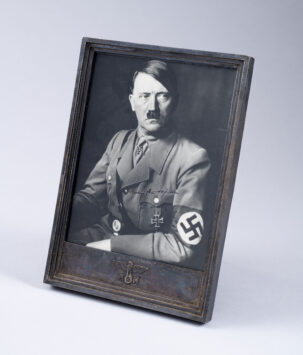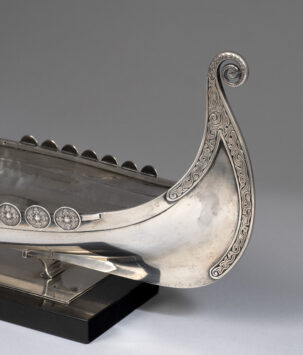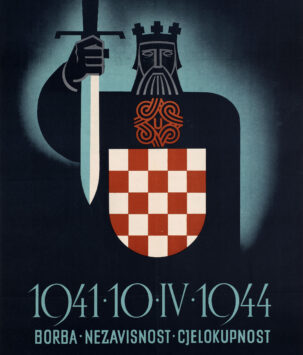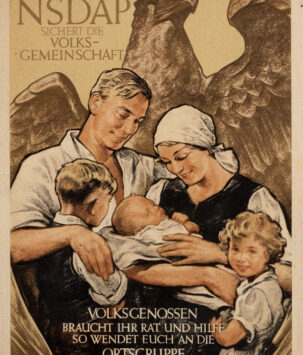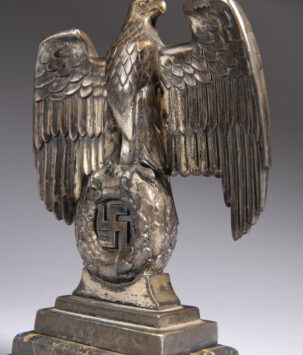Showing 1–12 of 53 results
-
A gold Andreas Huber reversible wristwatch gifted to Adolf Hitler himself on April 20th, 1933, his first birthday as Führer. One of a kind timepiece of unprecedented historical significance and conclusive provenance. Seized May 4th, 1945 at Hitler’s retreat in Berchtesgaden, Bavaria by a sergeant serving in the French 2nd Armored Division.
-
Autographed portrait of none other than Adolf Hitler himself within an official presentation frame emblazoned with an eagle and his initials “A H”. Photo by Heinrich Hoffman with dedication reading “Berlin dem 11 Mai” followed by the Führer’s signature.
-
Principal part of a larger sculpture known as ‘Empire Springs from the Mind of Il Duce‘ or ‘L’Impero balza dalla mente del Duce‘ in Italian, Ferruccio Vecchi masterfully portrays Mussolini as the Fascist superman destined to lead Italy to glory. A strong cult of personality was constructed around Mussolini, not only to inspire loyalty but for him to serve as a role model for the citizenry as an idealized vision for Italy’s ‘New Man’.
-
Sculpture by Stanisław Szukalski as featured in the eponymous Netflix documentary, Struggle. Created in 1917, this piece depicts the infighting of the great powers of Europe during the First World War, with the hand representing European civilization. The opposing fingers, or nations of Europe, turn against one another failing to recognize they are but one.
-
The insignia of the SS is a pair of ancient Germanic runes. As the political vanguards of Nazism, the SS sought to distinguish themselves by incorporating esoteric symbolisms and mystical rituals to forge a sense of camaraderie within its ranks and ideological training was designed to foster an attitude of energetic ruthlessness, reflected in the undeniably aggressive posturing of their runic insignia.
-
Belgian recruitment poster for the Waffen-SS replacement troops. Illustrated by F. Bertau in 1944, the poster is unparalleled in its dynamism and visual literacy. The potent symbolism and cartoonish style make the piece both unique to the era and unlike any other from it. A visually entertaining poster that manages to non-verbally communicate all its intended ideas through its vivid composition and succinct symbolism.
-

Schutzstaffel (SS) recruitment poster from German-occupied Norway brimming with mythological imagery from Germanic Paganism. Found within this poster is a profound esoteric symbology that captures the essence of neopagan National Socialist cosmology. Combining the quadratic themes of each arm of the swastika presents a singular, divine whole. The horizontal axis represents temporality, with the left and right arms symbolizing past and present, respectively, while the vertical axis represents the theory of metaphysical dualism. An iconic element of Norway’s heritage, ancient Vikings warriors are reflected on the right by their modern descendants, legionnaires of the Norwegian Waffen-SS. In the center is the revered god of war, Odin. The cosmic tree Yggdrasil forms the top arm as the axis mundi of Norse cosmology, bridging the celestial realms to the terrestrial, rooted in our soil but with its branches reaching far into the heavens. A humble Aryan family and a valiant SS patriarch comprising the bottom arm can be seen defending his homestead from the ravenous dragon of Judeo-Bolshevism.
-
Silver longship awarded to SS-Obersturmbannführer Hans-Hendrik Neumann by Norwegian prime minister Vidkun Quisling for his advisory role during the German occupation.
-
Election poster promoting Norway’s far-right Nasjonal Samling (National Assembly) party, founded in May 1933 by Vidkun Quisling. The sun in the form of a pagan sun cross rises behind a raven which was veneratedin old Norse Viking mythology as Odin’s divine messenger. Akin to the German National Socialists they were modeled on, the Nasjonal Samling rejected Christianity and drew much of its imagery from paganism which they saw as a more authentically Norwegian faith. Although the party never enjoyed any electoral success, Quisling and his party collaborated with the Germans upon the invasion of Norway. Following his deposition in 1945, the very term ‘Quisling’ would later become synonymous with ‘traitor’ in the Scandinavian languages.
-
Poster celebrating the establishment of the Independent State of Croatia. An ethereal nimbus of light surrounds a king bearing the insignia of the Ustaše.
-
The Volksgemeinschaft (people’s community) refers to a homogenous national community in citizens are united by a common culture, language and goal as well as a shared sense of identity that would overcome class conflict. It is characterized by solidarity, cohesion and equality, and expects the selfless devotion of every individual towards the betterment of the larger community which is considered an extension of oneself.
-
Eagle dated 1939 modeled after the massive iron eagles found on each side of the main podium of the Party Rally Grounds in Nuremberg. Designed by the preeminent sculptor Dr. Kurt Schmid-Ehmen who conceived the official design for the Third Reich’s national eagle.

